If you’re a proud bearded dragon owner, you’ve likely asked yourself at some point: can bearded dragons have spinach as part of their diet? With so many leafy greens available, it’s tempting to toss in whatever’s in your fridge—but not all vegetables are created equal when it comes to reptile nutrition.
In fact, the question “can bearded dragons have spinach safely?” comes up often in reptile forums and vet consultations. While spinach is loaded with vitamins, it also contains compounds that could pose risks to your dragon’s health if not offered carefully.
In this article, we’ll dive deep into whether bearded dragons can have spinach, how often it might be okay, what the hidden dangers are, and what safer alternatives you should consider instead. Let’s get started!
What Makes Spinach a Controversial Food for Reptiles?
While spinach is often praised for its nutritional value in human diets, it’s a bit more controversial when it comes to reptile nutrition. For bearded dragons, the presence of compounds like oxalates and an imbalanced calcium-to-phosphorus ratio can make spinach more harmful than helpful. Let’s take a closer look at the specific concerns behind feeding spinach to your beardie.
Oxalates in Spinach: A Hidden Danger for Bearded Dragons
Spinach is packed with oxalates, also known as oxalic acid—compounds that may seem harmless but have a serious effect on your bearded dragon’s health. These oxalates bind to calcium during digestion, making it difficult for your dragon to absorb this essential mineral. Since bearded dragons need high calcium levels to prevent metabolic bone disease, even small amounts of spinach can interfere with their bone strength, muscle control, and overall well-being. That’s why many experts suggest avoiding spinach entirely or feeding it only on rare occasions.
Can Bearded Dragons Have Spinach With a Balanced Calcium-Phosphorus Ratio?
Another major issue with spinach is its poor calcium-to-phosphorus ratio. Bearded dragons thrive on a diet that provides about 2 parts calcium to 1 part phosphorus. Spinach flips that ratio, offering more phosphorus than calcium. When phosphorus is too high, it can actually pull calcium out of the bones, weakening your dragon over time—even if you’re using calcium supplements. Feeding spinach frequently may slowly create deficiencies that lead to tremors, soft bones, and irreversible damage.
Spinach and Vitamin A: Can Bearded Dragons Have Spinach Without Overdosing?
Spinach also contains high levels of vitamin A, which can be both beneficial and risky. In small amounts, it supports vision, immune health, and skin. But when combined with vitamin-rich supplements—especially those containing preformed vitamin A or beta-carotene—spinach can tip the balance. Vitamin A toxicity is a real concern for reptiles and may show up as swelling, fatigue, or appetite loss. That’s why it’s smart to limit spinach intake, especially if your bearded dragon already receives regular multivitamins.
Why Reptile Vets Warn About Feeding Spinach to Bearded Dragons
Many reptile veterinarians recommend avoiding spinach in a bearded dragon’s diet. Although spinach isn’t outright toxic, its combination of oxalates, poor mineral balance, and high vitamin A content makes it a risky choice. Vets often treat dragons with diet-related issues that stem from frequent spinach feeding. Instead, they suggest offering safer greens like collard greens, mustard greens, or dandelion greens—nutrient-rich options that support health without hidden side effects.
Is Spinach Ever Safe for Bearded Dragons to Eat?
Spinach may not be ideal as a regular food, but many owners still wonder—is spinach ever safe for bearded dragons to eat at all? The answer depends on how much, how often, and what other foods are in your dragon’s diet. In this section, we’ll explore when spinach might be okay in small amounts and what precautions to take if you decide to offer it.
Occasional Feeding vs. Regular Inclusion
When it comes to feeding spinach to bearded dragons, moderation is essential. Spinach is not poisonous, but it’s not a recommended staple either. It should never replace calcium-rich, low-oxalate greens. Due to the high oxalate content, feeding spinach too often can prevent calcium absorption and lead to serious health issues like metabolic bone disease.
So, how often can bearded dragons eat spinach? The best practice is to offer it very sparingly. Once every 3 to 4 weeks is the upper limit for a healthy adult. Some keepers prefer to avoid it altogether, especially if the dragon already receives vitamin or calcium supplements. Spinach may be okay as a rare treat, but it should never become part of your dragon’s regular feeding routine.
Quantity and Frequency Guidelines
According to most trusted bearded dragon food charts, spinach falls under the “rare treat” category. A single small leaf—washed, finely chopped, and mixed with other greens—is more than enough. For an adult bearded dragon, you might offer this once a month or less. More frequent servings increase the risk of calcium deficiency.
If spinach is served, pair it with calcium-rich options like mustard greens or collard greens to help offset its oxalate content. Never feed spinach for multiple meals in a row. Avoid giving spinach at all if you’re unsure of your dragon’s calcium intake or if you’re already supplementing with vitamins. Careful portion control helps maintain a balanced and safe diet.
Age Considerations: Hatchlings vs. Adults
Young bearded dragons (Pogona vitticeps), especially hatchlings, have different nutritional needs than adults. During early growth, their bones and muscles require steady calcium intake. Any food that blocks calcium—like spinach—is considered high-risk for young dragons. Even a small serving can affect development.
For this reason, spinach should never be fed to hatchlings or juveniles. It can interfere with growth, weaken the skeleton, and delay healthy development. Adults have more dietary flexibility, but even then, spinach should be an occasional treat at most. Always consider age when planning your bearded dragon’s meals. What may be safe for a mature dragon could be dangerous for a baby.
Safer Leafy Greens to Offer Instead of Spinach
While spinach should only be fed occasionally, there are plenty of leafy greens that are both nutritious and safe for regular feeding. These alternatives offer essential vitamins and minerals without the risks associated with oxalates. Let’s explore some of the best greens to include in your bearded dragon’s diet.
Instead of spinach, consider safer vegetables like dandelion, collard, and turnip greens—and even cabbage in small amounts.
Curious about cabbage? Can bearded dragons eat cabbage?

Nutrient-Rich Alternatives (Dandelion, Collard, Turnip Greens)
When choosing leafy greens for your bearded dragon, focus on options that are low in oxalates and high in essential nutrients. Dandelion greens are one of the best choices. They offer a strong calcium content, along with fiber, vitamin A, and antioxidants. Collard greens are another excellent staple, known for their high calcium-to-phosphorus ratio and low oxalate content. They’re also rich in vitamin K and iron. Turnip greens round out the list with balanced nutrients and a slightly milder flavor, which some dragons prefer. These greens can safely be rotated into your dragon’s weekly meals and provide all the nutritional benefits without the risks associated with spinach.
Comparing Oxalate Levels in Common Greens
Oxalates are the main concern when feeding leafy vegetables to reptiles. Using a reliable oxalic acid chart, you’ll find that spinach ranks very high in oxalate content. In contrast, dandelion and collard greens contain very low levels. Turnip greens fall somewhere in the middle but are still considered safe. High-oxalate vegetables should be avoided or given rarely. Low-oxalate options can be fed more frequently. Understanding these differences helps prevent long-term health issues, especially those related to calcium absorption. Always check an updated oxalate chart when planning your dragon’s salad mix.
Texture and Digestibility of Different Leaves
Texture plays an important role in how well bearded dragons can digest leafy greens. Dandelion greens are soft and easy to chew, making them ideal even for younger dragons. Collard greens are thicker and should be finely chopped for easier digestion. Turnip greens offer a nice balance—tender but not mushy. Avoid fibrous or overly tough leaves, as they can cause impaction or be rejected entirely. Choosing greens with appropriate textures encourages healthy eating habits and supports better digestion. If your dragon turns its nose up at certain greens, try mixing textures for variety and improved palatability.
Which Greens Can Be Fed Daily?
Some greens are safe enough to be offered every day. Collard greens, dandelion greens, and mustard greens are commonly listed as daily staples on reptile food charts. These vegetables provide steady calcium, fiber, and hydration without interfering with nutrient absorption. Unlike spinach or kale, they don’t contain harmful levels of oxalates or goitrogens. Rotate your daily greens to give variety, but stick to safe options with proven benefits. Avoid feeding the same green every single day to prevent imbalances. A diverse salad mix ensures your dragon gets the nutrients it needs without the risks.
Understanding a Bearded Dragon’s Nutritional Needs
Feeding your bearded dragon isn’t just about avoiding harmful foods—it’s about providing a well-balanced, species-appropriate diet that supports long-term health. Understanding their nutritional needs helps you make informed choices about what to feed and how often. In this section, we’ll break down the key elements that contribute to a healthy and thriving dragon.
The Role of Calcium and UVB Exposure
Calcium is one of the most critical nutrients for bearded dragons. It supports bone development, muscle function, and proper metabolic activity. Without enough calcium, dragons are at high risk of developing Metabolic Bone Disease (MBD)—a painful, often irreversible condition that weakens the bones. However, calcium alone isn’t enough. Dragons also require proper UVB lighting to synthesize and absorb calcium efficiently.
Without UVB exposure, even the best diet will fall short. UVB rays allow the dragon’s body to produce vitamin D3, which is essential for calcium metabolism. Your enclosure should include a high-quality UVB bulb designed for reptiles, positioned at the correct distance and replaced every 6–12 months. Combine this with a calcium-rich diet and supplements as needed. Together, diet and UVB create the foundation for strong bones and overall well-being.
Balancing Veggies with Insects and Fruits
Bearded dragons are omnivores, and their diet must reflect that balance. Vegetables, insects, and fruits all play a role in keeping them healthy. Adult dragons typically need about 70–80% plant-based food and 20–30% animal protein. For younger dragons, the ratio shifts to include more insects to support rapid growth.
Vegetables should form the bulk of the plant portion, with safe options like collard greens, mustard greens, and squash. Fruits should be used sparingly due to their sugar content. Insects like crickets, dubia roaches, and mealworms provide protein and stimulate natural hunting behavior. Too much fruit or protein can upset digestion or lead to obesity. A well-balanced rotation of ingredients ensures proper bearded dragon diet safety and keeps them interested in their meals.
Signs of Nutritional Imbalance in Bearded Dragons
Recognizing early signs of a poor diet is crucial to protecting your dragon’s health. One of the most common red flags is lethargy, especially if your dragon becomes less active or stops basking. Soft or swollen limbs can be a sign of calcium deficiency. Metabolic Bone Disease often presents as tremors, a curved spine, or difficulty moving.
Other symptoms of poor nutrition include a dull, flaky appearance, lack of appetite, or irregular bowel movements. In severe cases, dragons may exhibit visible weight loss or bloating. Monitoring reptile health symptoms regularly allows you to catch problems early and adjust the diet accordingly. If you’re ever unsure, consult a reptile vet for a full health check and feeding evaluation.
Frequently Asked Questions About Feeding Spinach
Is spinach toxic to bearded dragons?
Spinach is not toxic in the traditional sense, but it can become harmful if fed too often. The high oxalate content binds to calcium, preventing proper absorption. Over time, this can lead to serious health problems like metabolic bone disease.
Can bearded dragons have spinach leaves every day?
No, bearded dragons should not have spinach every day. While the leaves may seem harmless, daily feeding can create a calcium deficiency. Spinach should only be offered occasionally, no more than once a month.
Can bearded dragons have spinach and carrots together?
It’s possible, but not ideal. Both spinach and carrots are high in certain compounds that can interfere with calcium or vitamin A levels when overfed. If given together, it should be in very small amounts and only as a rare treat.
Can baby bearded dragons eat spinach?
Baby bearded dragons should not eat spinach at all. Their growing bones and developing systems are more vulnerable to calcium absorption issues. Stick to low-oxalate, high-calcium greens for hatchlings and juveniles.
What happens if my dragon eats too much spinach?
If your dragon consumes spinach frequently, it may start to show signs of calcium deficiency. These can include lethargy, swollen limbs, soft jaw, and tremors. Long-term overfeeding can lead to metabolic bone disease.
What should I do if my dragon shows signs of calcium deficiency?
Immediately stop feeding high-oxalate foods like spinach. Increase calcium supplementation, ensure proper UVB lighting, and consult a reptile vet. Early intervention is key to preventing permanent bone damage.
Can bearded dragons eat kale or lettuce instead?
Kale is better than spinach in small amounts, though it still contains moderate oxalates. Lettuce (especially iceberg) is not recommended due to its low nutritional value and high water content. Stick to nutrient-rich greens like collards or dandelion greens for regular meals.
Can bearded dragons eat kale every day?
Not daily. While kale is safer than spinach, its moderate oxalate levels and potential goitrogens make it better suited for occasional feeding. Use it in rotation with safer, calcium-rich greens.
Can bearded dragons eat arugula?
Yes, arugula is a safe green for bearded dragons. It’s low in oxalates and offers a peppery flavor that many dragons enjoy. However, it should be part of a varied diet, not the only green offered.
What greens can bearded dragons eat regularly?
The best daily greens include collard greens, mustard greens, turnip greens, and dandelion greens. These are low in oxalates and high in calcium, making them ideal staples for your dragon’s long-term health.
Conclusion
So, can bearded dragons have spinach? The short answer is yes—but only in very limited amounts and on rare occasions. While spinach does offer some nutrients, its high oxalate content and poor calcium-to-phosphorus ratio make it a risky choice, especially for young or growing dragons. Feeding spinach too often can lead to calcium deficiency, metabolic bone disease, and long-term health issues.
Instead, focus on safer leafy greens like dandelion, collard, and turnip greens, which provide essential vitamins without the risks. Always aim for a balanced diet that includes a variety of vegetables, safe fruits, and protein-rich insects—supported by proper UVB lighting and calcium supplementation.
Making informed choices about your bearded dragon’s diet helps ensure a long, healthy, and happy life for your scaly companion. When in doubt, stick with the safest options—and don’t hesitate to consult a reptile vet for personalized guidance.
Diet isn’t the only thing that affects your bearded dragon’s health—genetics matter too. Discover the top morphs from bearded dragon selective breeding and how traits like size or skin type can influence care needs.

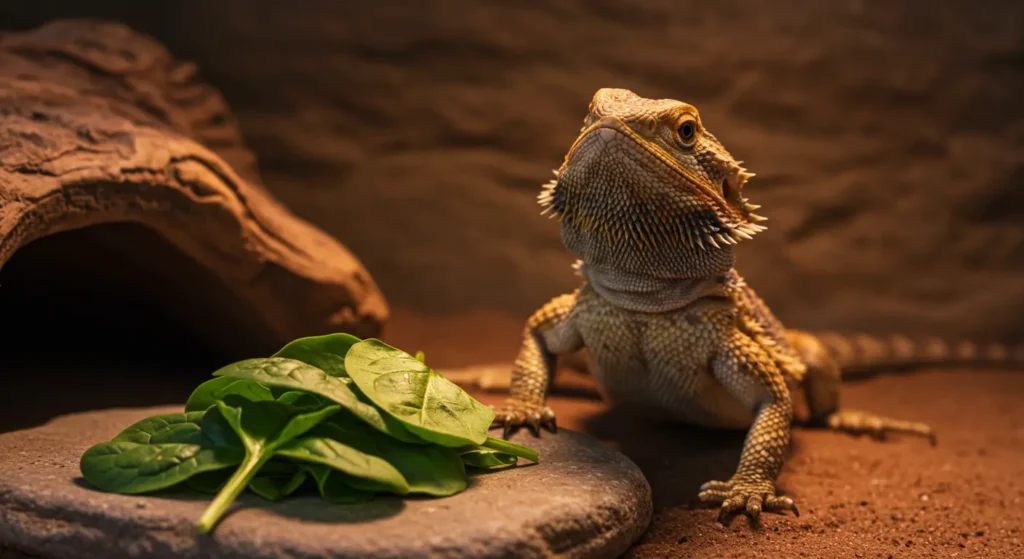
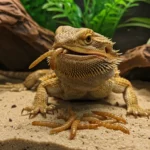
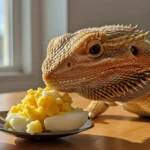
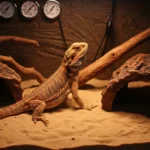
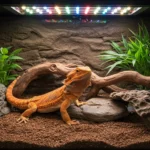
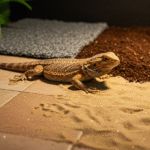
6 thoughts on “Can Bearded Dragons Have Spinach? Simplified Guide”